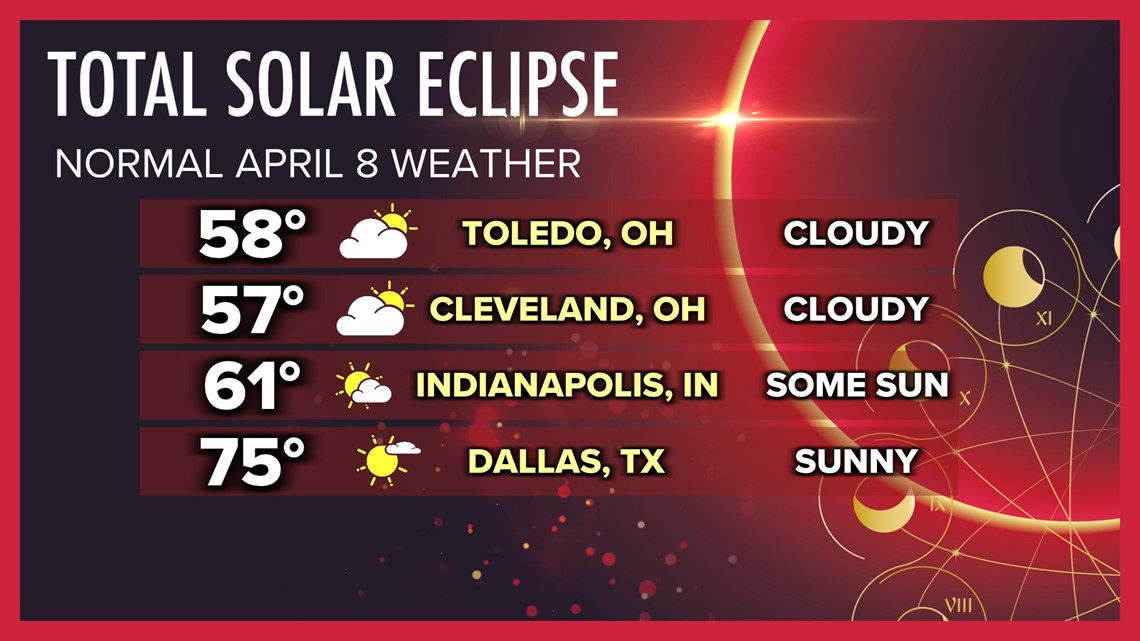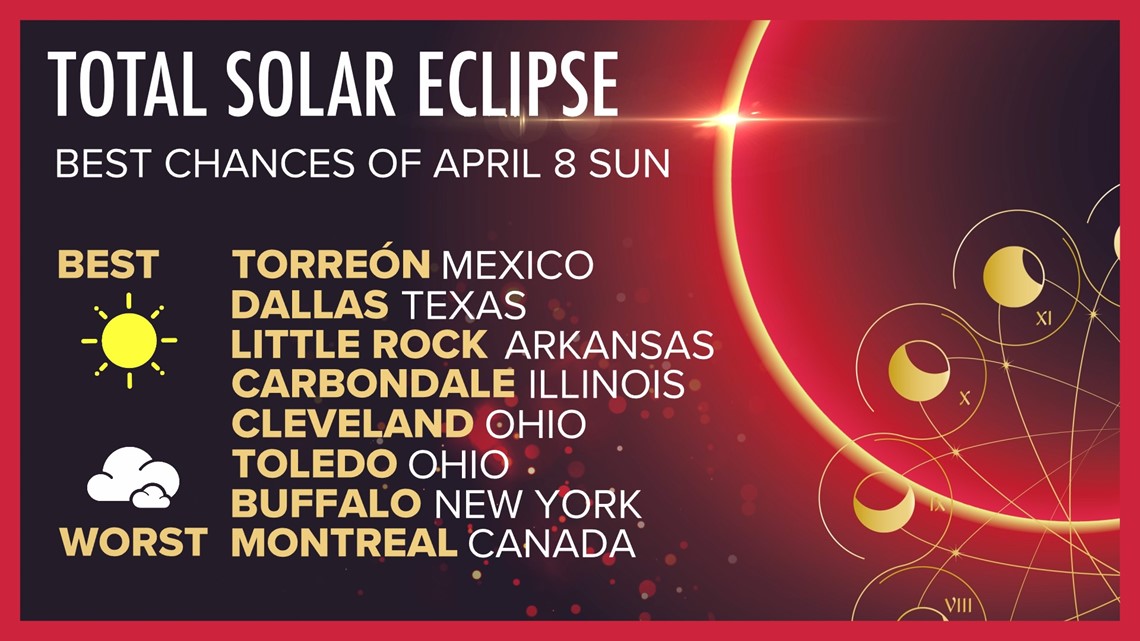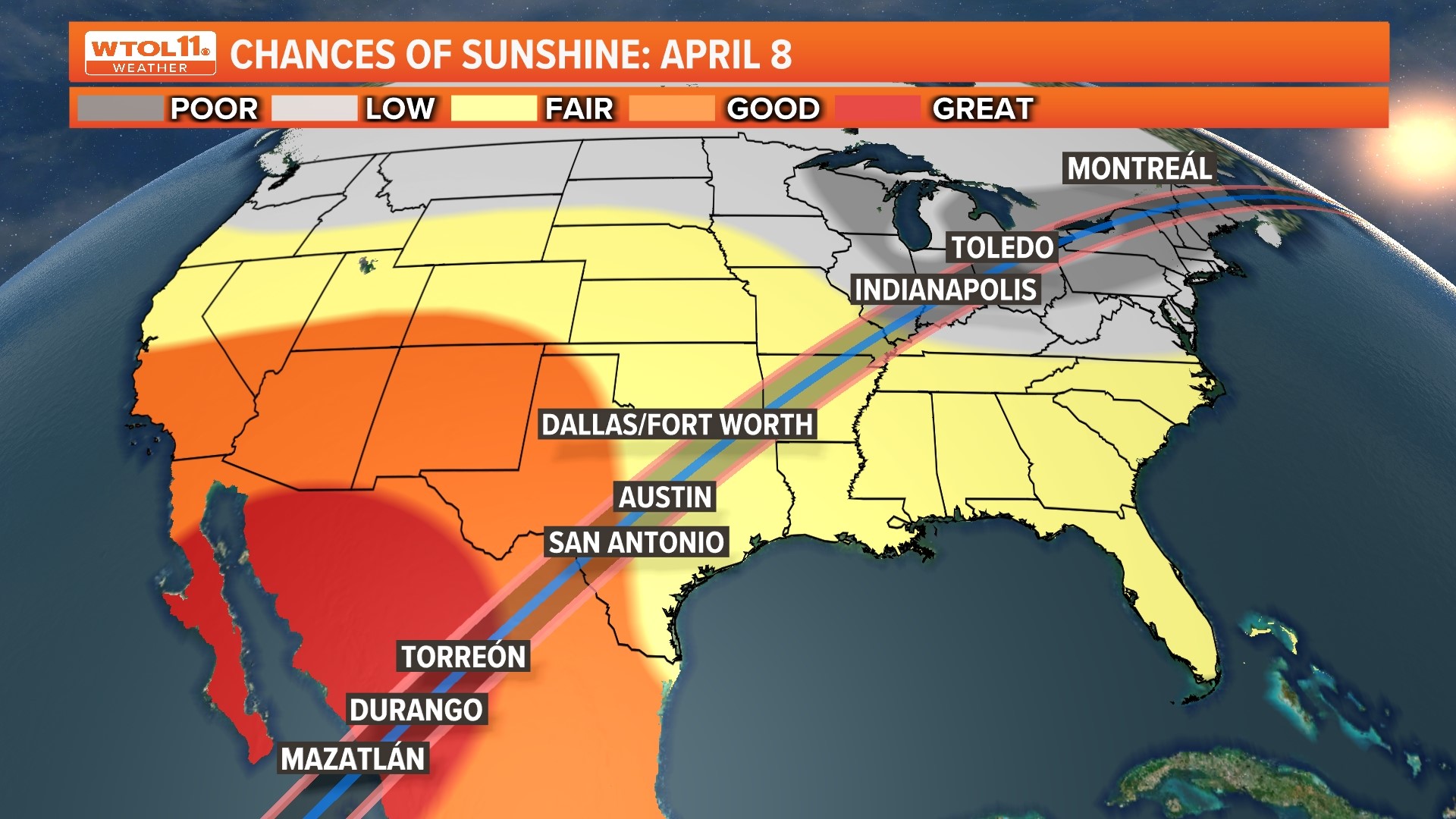TOLEDO, Ohio — The total solar eclipse is now just a little over two weeks away and you may be making final preparations for the once-in-a-lifetime spectacle. Though April 8 is still outside the range of the 10-day forecast, long-range trends can help shed light on the weather conditions you can expect for the big day.
Early April is often a wild card weather-wise and can bring a mixed bag of conditions ranging from rain to sunshine, and warmth to cold. In Toledo, April 8 typically brings a high temperature of 58 degrees with mostly cloudy skies. Much of the Great Lakes region experiences similarly cool and cloudy early April weather. Other cities in totality including Buffalo, New York and Erie, Pennsylvania average temperatures in the 50s with dense cloud cover in early April.
Cities further south including Carbondale, Illinois and Indianapolis, Indiana typically feel milder conditions in the 60s in early April. Sunshine is statistically more likely further southwest, and cities in totality such as Dallas, Texas average sunny skies with high temperatures in the mid-70s on April 8.


While cloud cover is highly variable on the weather pattern and jet stream, climatology tells us that sunny weather is more likely in the southwestern United States in the spring. Many Texas cities in totality, such as Dallas, Austin, and San Antonio, have good chances at sunny weather on April 8.
Mexican cities in totality such as Torreón, Durango, and Mazatlán have great odds at a sunny day. Across the Midwest and northeast, cities like Indianapolis, Toledo, Cleveland, Erie, and Buffalo tend to experience more overcast conditions in early April. While spring sunshine can occur, it's statistically less likely.


Even though April is often cloudy in northwest Ohio, it can bring bright sunshine from time to time. April 8, 2023 featured brilliant Sun for much of the lower Great Lakes. Toledo felt a seasonable temperature of 59 degrees with crystal clear skies.
Temperatures topped out at 54 degrees under sunny skies in Cleveland. Indianapolis felt a milder setting with highs in the low-60s and partly sunny conditions. Ironically, one of the statistically sunniest cities in totality, Dallas, was mostly cloudy with a high of 74 on April 8, 2023.


While last April 8 brought sunshine for much of the Midwest, the prior year delivered spring clouds and showers. Toledo, Cleveland, and Indianapolis each experienced rain showers with high temperatures near 50 degrees on April 8, 2022. Dallas, Texas saw seasonable sunshine with temperatures a bit cooler than average at 69 degrees.
RELATED: Will the temperature drop during totality? How the total solar eclipse can affect the weather
While climatology provides some insight into what early April can bring, the short-term weather pattern will determine our chances of Sun for the total solar eclipse.
Though April 8 is still far beyond the end of the 10-day forecast, the WTOL 11 Weather Team is studying long-range trends that may impact conditions on April 8. This week has brought unseasonably chilly conditions with a trough, or dip in the jet stream ushering in brisk weather for much of the Great Lakes.


While this weather pattern will briefly give way to a milder setting into the last week of March, early April will likely start off a bit cooler than average. With our normal high temperature climbing to 58 degrees by eclipse day, a relatively cool feeling day could feature highs in the 40s or even low-50s. The long-range trend will likely remain cooler than average for most of the western and central United States.
Chances of a milder feel for viewing the total solar eclipse are greater in New England. The path of totality stretches through New York, Vermont, New Hampshire, and Maine, states that will likely experience above average temperatures. Precipitation is a bit harder to predict several weeks out, especially since storm systems that may impact the eclipse haven't even developed yet. Computer models that project long-range trends have indicated that precipitation will likely remain near normal to slightly wetter than average.


Regardless of rain or the lack thereof, grey clouds are statistically very likely in early April. Normally, the sky is 60-70% covered in clouds in April. While long-range trends are indicating the potential for a slightly cooler and wetter trend into early April, specific details won't become more clear for another week or so. Stay tuned as the WTOL 11 weather team fine-tunes the forecast for the total solar eclipse.
WATCH MORE FROM WTOL 11

